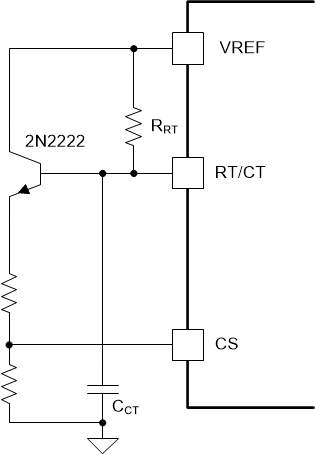ZHCSPH5C June 2022 – March 2023 UCC28C50 , UCC28C51 , UCC28C52 , UCC28C53 , UCC28C54 , UCC28C55 , UCC28C56H , UCC28C56L , UCC28C57H , UCC28C57L , UCC28C58 , UCC28C59 , UCC38C50 , UCC38C51 , UCC38C52 , UCC38C53 , UCC38C54 , UCC38C55
PRODUCTION DATA
8.3.10 电压模式
在某些应用中,出于各种原因,电压模式控制可能是优选的控制策略。电压模式控制可通过任何电流模式控制器轻松执行,尤其是 UCC28C5x 系列成员。该实现需要生成 0V 至 0.9V 锯齿形信号,以输入到电流检测引脚 (CS),该引脚也是 PWM 比较器的一个输入。这将与 PWM 比较器另一个输入端的分压误差放大器输出电压进行比较。由于误差放大器输出会变化,它会在不同时间点与锯齿波形相交,从而产生不同的脉冲宽度。这是一种线性生成脉冲的直接方法,其中脉冲的宽度与误差电压成正比。
电压模式控制的实现可以通过使用振荡器计时电容 (CCT) 的一小部分波形来实现。该值可以进行分频并馈入电流检测引脚,如图 8-9 所示。选择的振荡器时序分量必须尽可能接近线性锯齿波形。尽管以指数方式充电,但较大的计时电阻值和较小的计时电容值有助于近似呈现线性度更高的波形。这里使用了一个小型晶体管来缓冲来自电阻分压器网络负载的振荡器时序分量。由于振荡器的下限计时阈值发生偏移,因此增加了直流阻断电容器。
 图 8-9 电流模式 PWM 用作电压模式 PWM
图 8-9 电流模式 PWM 用作电压模式 PWM